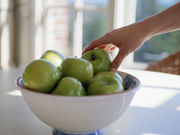But second report found women who drink more alcohol over time might increase chances of disease
THURSDAY, May 12, 2016 (HealthDay News) — Teenage girls who consume large amounts of fruit may lower their future risk for breast cancer; however, women who drink more alcohol over time might increase their breast cancer risk, according to two studies published online May 11 in The BMJ.
In the fruit study, Maryam Farvid, Ph.D., research associate in the department of nutrition at the Harvard T.H. Chan School of Public Health in Boston, and colleagues analyzed food questionnaires completed in 1991 by 90,476 women — aged 27 to 44 — who had enrolled in the Nurses’ Health Study II two years earlier. In 1998, 44,223 of the women completed a second food survey. That survey asked participants to recall what food they had consumed during adolescence.
Over the two decades of the study, 3,235 women developed invasive breast cancer. Adolescent dietary information was available for 1,347 of those women. Consumption of apples, bananas, and grapes during adolescence was strongly associated with a drop in breast cancer risk. Roughly three daily servings of such fruits were linked to a 25 percent drop in risk by middle age, compared with consuming just a half-serving per day. Women who ate oranges and/or kale as young adults also seemed to gain some protection from breast cancer.
The second study, led by Marie Dam of the University of Southern Denmark in Copenhagen, tracked alcohol patterns among 21,523 postmenopausal women between 1993 and 1998, and again between 1999 and 2003. The team concluded that breast cancer risk increased by up to 30 percent for women who increased their overall alcohol intake by one or two drinks per day (over either five-year period). However, heart disease risk decreased by up to 22 percent, relative to women whose drinking patterns didn’t change.
Copyright © 2016 HealthDay. All rights reserved.








